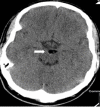Auditory Hallucinosis as a Presenting Feature of Interpeduncular Lipoma with Proximal P1 Segment Fenestration: Report of a Rare Case and Review of Literature on Peduncular Hallucinosis
- PMID: 27403217
- PMCID: PMC4925759
Auditory Hallucinosis as a Presenting Feature of Interpeduncular Lipoma with Proximal P1 Segment Fenestration: Report of a Rare Case and Review of Literature on Peduncular Hallucinosis
Abstract
The authors present a unique case of intracranial lipoma in the interpeduncular cistern associated with proximal P1 segment fenestration. This patient is a 20-year-old male with extensive psychiatric history and complaints of recent auditory hallucinations. Cranial magnetic resonance imaging (MRI) (T1, T2, and FLAIR) showed a hyperintense lesion in the left aspect of interpeduncular cistern with a prominent flow void within the hyperintense lesion suggestive of a combined vascular-lipomatous lesion. Computed tomography (CT) angiography showed a high-riding large tortuous P1 segment on the left side with proximal fenestration, the ectatic posteromedial limb harboring a fusiform dilated segment. Since there are anecdotal cases of cerebral aneurysms associated with intracranial lipomas, a conventional angiography was done, which confirmed a proximal left P1 fenestration and a fusiform-dilated segment, and no aneurysm. There are few cases of hallucinations associated with a vascular midbrain pathology reported in literature, but hallucinations associated with a combination of lipoma and arterial ectasia have never been reported. This article not only demonstrates the MRI and angiographic appearance of this rare lipomatous lesion but also highlights this unique association and significance of auditory hallucinations as a clinical presentation, akin to peduncular hallucinosis.
Keywords: Auditory hallucinosis; interpeduncular lipoma; peduncular hallucinosis; posterior cerebral artery fenestration; vascular ectasia.
Figures




Similar articles
-
Peduncular hallucinosis associated with pontine hemorrhage in an adult patient.Psychiatriki. 2024 Mar 28;35(1):78-82. doi: 10.22365/jpsych.2023.026. Epub 2023 Nov 14. Psychiatriki. 2024. PMID: 37982250
-
Peduncular hallucinosis after a thalamic stroke.BMJ Case Rep. 2021 May 13;14(5):e241652. doi: 10.1136/bcr-2021-241652. BMJ Case Rep. 2021. PMID: 33986011 Free PMC article.
-
A case of peduncular hallucinosis due to a pontine infarction: a rare complication of coronary angiography.Hippokratia. 2015 Jul-Sep;19(3):268-9. Hippokratia. 2015. PMID: 27418790 Free PMC article.
-
Peduncular hallucinosis after debulking of a third ventricular pilocytic astrocytoma: Case report and review of the literature.J Clin Neurosci. 2021 Jan;83:96-98. doi: 10.1016/j.jocn.2020.11.021. Epub 2020 Dec 15. J Clin Neurosci. 2021. PMID: 33339693 Review.
-
Unilateral double fenestration of the same posterior cerebral artery at P1 segment: first cadaveric case report and literature review.Surg Radiol Anat. 2024 Dec;46(12):1959-1963. doi: 10.1007/s00276-024-03495-7. Epub 2024 Nov 11. Surg Radiol Anat. 2024. PMID: 39527251 Review.
Cited by
-
Peduncular hallucinosis associated with a pontine cavernoma.Ment Illn. 2018 May 16;10(1):7586. doi: 10.4081/mi.2018.7586. eCollection 2018 May 15. Ment Illn. 2018. PMID: 30046405 Free PMC article.
References
-
- Truwit CL, Barkovich AJ. Pathogenesis of intracranial lipoma: an MR study in 42 patients. AJR Am J Roentgenol. 1990;155(4):855–864. discussion 865. - PubMed
-
- Verga P. Lipoma ed osteolipomi della pia madre. Tumori. 1929;15:321–57.
-
- Ghosh GSVK. Peduncular hallucinosis: an unusual case of visual hallucination in a delirious patient. J Med Case. 2013;4(3):176–8.
-
- Lhermitte J. Syndrome de la calotte du Pedoncule cérébral. Les troubles psycho-sensoriels dans les lesions du mésocéphale. Rev Neurol. 1922;2:1359–65.
-
- Risser AH, Powell FC. Paper presented at the 45th Meeting of the American Academy of Neurology. New York: 1993. Lhermitte's peduncular hallucinosis – an historical perspective.
LinkOut - more resources
Full Text Sources
